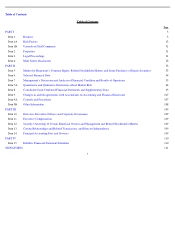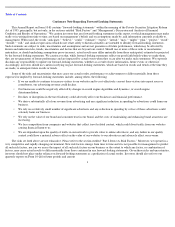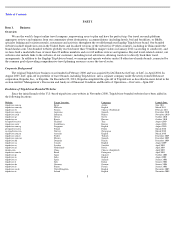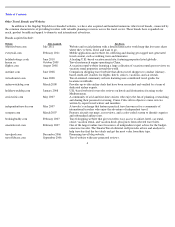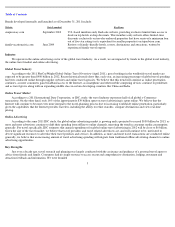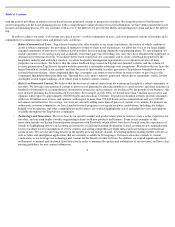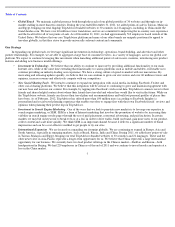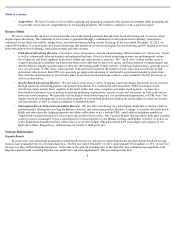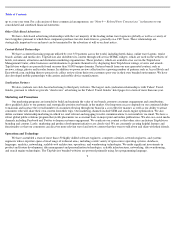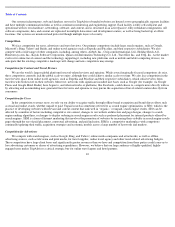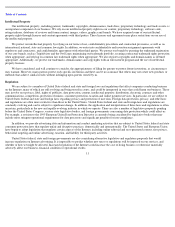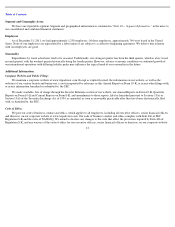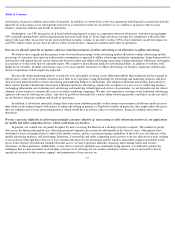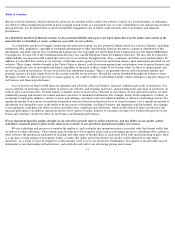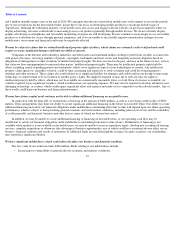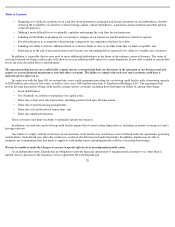TripAdvisor 2011 Annual Report Download - page 14
Download and view the complete annual report
Please find page 14 of the 2011 TripAdvisor annual report below. You can navigate through the pages in the report by either clicking on the pages listed below, or by using the keyword search tool below to find specific information within the annual report.
Table of Contents
Our systems infrastructure, web and database servers for TripAdvisor branded websites are housed at two geographically separate facilities
and have multiple communication links as well as continuous monitoring and engineering support. Each facility is fully self-sufficient and
operational with its own hardware, networking, software, and content, and is structured in an active/passive, fully redundant configuration. All
software components, data, and content are replicated in multiple datacenters and development centers, as well as being backed up at offsite
locations. Our systems are monitored and protected though multiple layers of security.
Competition
We face competition for users, advertisers and travel reviews. Our primary competitors include large search engines, such as Google,
Microsoft’s Bing, Yahoo! and Baidu, and online travel agencies such as Expedia and Priceline, and their respective subsidiaries. We also
compete with a wide range of other companies, including, among others, Airbnb, Inc., Ctrip.com International, Ltd., HolidayCheck AG,
HomeAway.com, Inc., Kayak Software Corporation, Qunar.com Information Technology Co. Ltd., TravelZoo Inc. and Yelp, Inc. As the market
evolves for online travel content and the technology supporting it, including new platforms such as mobile and tablet computing devices, we
anticipate that the existing competitive landscape will change and new competitors may emerge.
Competition for Content and Travel Reviews
We are the world’s largest global platform for travel-related reviews and opinions. While several regionally-focused competitors do exist,
these competitors currently lack the global scale we enjoy, although they could achieve similar scale over time. We also face competition in the
travel review space from online travel agencies, such as Expedia and Priceline and their respective subsidiaries, which solicit reviews from
travelers who book travel on their websites. Moreover, networks with significant installed user bases such as Google (for example, via Google
Places and Google Hotel Finder) have begun to, and other networks or platforms, like Facebook, could choose to, compete more directly with us
by attracting and accumulating user-generated travel reviews and opinions or may pursue the acquisition of travel-related content directly from
consumers.
Competition for Users
In the competition to attract users, we rely on our ability to acquire traffic through offline brand recognition and brand-direct efforts such
as email and online search, whether unpaid or paid. Unpaid search is sometimes referred to as search engine optimization, or SEO, which is the
practice of developing websites with relevant and current content that rank well in “organic,” or unpaid, search engine results. SEO can be
affected by a number of factors including competitive site content, changes to our website architecture and page designs, changes to search
engine ranking algorithms, or changes to display ordering in search engine results such as preferred placement for internal products offered by
search engines. SEM is a form of Internet marketing that involves the promotion of websites by increasing their visibility in search engine results
pages through the use of paid placement, contextual advertising, and paid inclusion. SEM is a competitive marketplace with competitors
continually updating their traffic acquisition strategies and economic models across a large number of keywords and markets.
Competition for Advertisers
We compete with search engines, such as Google, Bing, and Yahoo!, online media companies and ad networks, as well as offline
advertising sources, such as television and print media, for travel supplier, online travel agency and other travel-related advertising budgets.
These competitors have large client bases and significantly greater resources than we have and competition from these parties could cause us to
lose advertising customers or shares of advertising expenditures. However, we believe that our large audience of highly-qualified, highly-
engaged users makes TripAdvisor a critical strategic buy for online travel agents and hotel partners.
10


